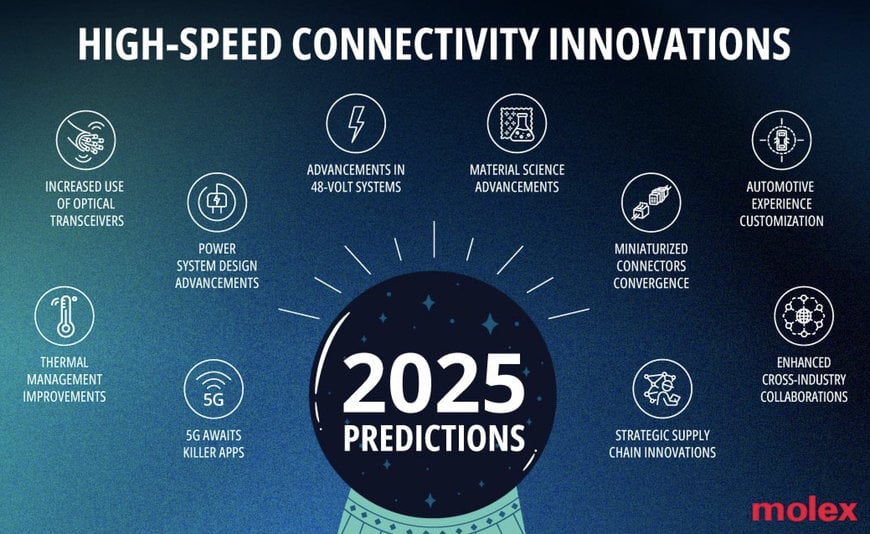Molex Predicts Growth in High-Speed Connectivity Solutions for 2025
Increase in opportunities predicted for high-speed optical transceivers and miniaturized connectivity solutions to address data-intensive applications.
www.molex.com

Molex predicts an uptick in reliable, durable, high-speed interconnects over the next 12-to-18 months as the impact of generative artificial intelligence (AI), machine learning (ML) and cloud solutions intensifies across every sector, including data centers, automotive, consumer electronics and medical technology. Increased collaboration among electronics product designers, manufacturing engineers and supply chain specialists also will be needed to address ever-increasing requirements for innovations in thermal and power management, material science, and battery technology, among other pressing priorities.
“We anticipate a consistent rise in connectivity-related solutions in 2025 that will drive advancements in hyperscale data centers and software-defined vehicles while reducing obstacles and barriers for smaller, yet more powerful consumer and MedTech devices,” said Mike Deppe, VP of Global Product Development, Molex. “The growing demand for data and instant access to information will continue to create both opportunities and challenges in connectivity, which we are prepared to address on behalf of our customers, suppliers and technology partners worldwide.”
Top 10 Predictions for 2025
1. Continued use of high-speed optical transceivers for hyperscale data centers
The rapid adoption of generative AI is escalating demand for massive processing and capacity scaling in hyperscale data centers. In response, operators are increasing their use of high-speed optical transceivers for both inter- and intra-rack connectivity to offer additional port density, greater signal integrity and reduced power consumption.
2. Spike in 224 Gbps PAM-4 interconnects requires thermal management improvements
With deployments of 224 Gbps PAM-4 interconnects growing and the path to 448 Gbps PAM-4 coming into view, it is clear that air-cooled data center solutions are reaching operational limits. This reality is driving the emergence of new thermal-management solutions, including liquid cooling solutions, such as direct-to-chip and immersion cooling. Molex is working closely with customers, power-ecosystem partners and groups like OCP to speed development of next-gen cooling technologies and standards.
3. Momentum in 48-Volt systems propels advancements in automotive functionality
By quadrupling system voltage, 48V technology boosts electric turbocharging, regenerative braking, infotainment systems, and battery preconditioning for auxiliary charging. The delivery of higher current and voltage also is crucial to increasing power efficiencies in sensors, actuators and control units needed for advanced driver assistance systems (ADAS).
4. Power systems remain one of the biggest product design engineering challenges
Unrelenting demand to balance power capacity, functional safety, efficiency, and cost and performance monitoring is driving aggressive investment and innovation in battery technology, along with solutions designed to reduce signal and power interference.
5. Slow pace of 5G rollouts will continue to stall as consumers await “killer apps”
The arrival of Meta’s Orion illuminates the future of AR glasses but will take time to drive 5G momentum. As “killer apps” emerge, the pace of 5G rollouts will gain speed accordingly amid rising requirements for high-speed wireless connectivity, along with the need for small, dense connectors, such as the millions of miniaturized connectors Molex supplies to leading mobile device manufacturers.
6. Convergence of ruggedized, miniaturized connectors will fuel cross-industry innovations
Use of compact, durable connectors with a pitch of 2.54mm or less will dominate in electric vehicles and zonal architectures while gaining major traction in other areas, including consumer electronics, medical devices, industrial automation and smart agriculture. Blending the best of miniaturization and ruggedization improves space efficiency, signal integrity and thermal management.
7. Advancements in material science balance strength, weight and sustainability
The use of digital twins, AI and material databases will continue to play ever-increasing roles in material characterization, processing innovation, selection, application engineering and testing. Expect more material science breakthroughs in building miniaturized connectors, especially in balancing strength, weight, conductivity, chemical resistance, sustainability, the use of bio-based materials, and more.
8. Mass customization and consumerization of the automotive experience varies by market
Vehicle architecture development will align with different driving preferences and experiences worldwide. In China’s dynamic market, ongoing experimentations will drive innovation while the European market, led by German automakers, considers a mix of technologies. American OEMs will advance software-driven architectures, particularly in passenger and sport utility vehicles.
9. Cross-Industry collaborations to thrive as design engineers tap different experiences
Continued cross-industry collaborations are expected to increase at an accelerated pace as design engineers leverage expertise in hyperscale data centers to address concerns and challenges in power and thermal management, sensor fusion and signal integrity in automotive and consumer electronics.
10. Ongoing supply chain volatility requires inventory rebalancing and supply optionality
Operationalizing intelligence and data to gain faster, more precise access to real-time insights will lead to better forecasting and risk management, with a shift toward predictive, scenario-based supply chain planning and faster, more adaptive decision making.
www.molex.com

